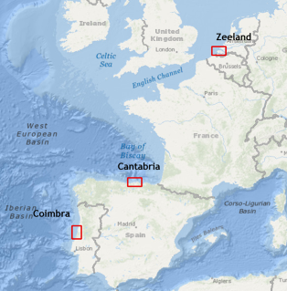About the project

The European littoral ecosystems are degraded due to intense economic and urbanistic activity and high population density within these areas. As a consequence, coastal areas are particularly vulnerable to the impacts of climate change. The expected scenarios predict a high risk of disasters within these areas, such as sea level rise or extreme weather events like floods or storms.
In Europe, approximately one fifth of the population lives within 10 km from the coast and many littoral areas are already below sea level. Therefore, there is a need for coastal communities to adapt to climate change risks. Thus far, most of the prevention actions have been based on built engineering solutions like dykes or seawalls. More recently, coastal managers worldwide are exploring Nature-based Solutions (NbS) as a sustainable alternative to deal with climate change risks in littoral areas.
The LIFE ADAPTA BLUES project aims to demonstrate that the conservation and restoration of estuarine ecosystems is an efficient strategy to enhance adaptation to climate change in coastal areas of the European Atlantic coast.
Project in numbers
Objectives
The LIFE ADAPTA BLUES project have these specific objectives to achieve its main goal.
Actions
The LIFE ADAPTA BLUES project will conduct different type of actions to meet its goals.
LIFE ADAPTA BLUES

The LIFE ADAPTA BLUES is develop in three different European regions: Coimbra (Portugal), Cantabria (Spain) and Zeeland (The Netherlands). Preparatory and implementation actions aiming to develop technical recommendations for Climate Change adaptation and mitigation pathways are based on five estuaries, distributed in the three regions of the project, the Mondego estuary in Coimbra, the Oyambre estuary, Santander Bay and Santoña Marshes in Cantabria and the Western Scheldt in Zeeland. These estuaries encompass a broad range of ecological and socioeconomical characteristics to represent the wide variety of estuaries in the Atlantic coast of Europe. In addition, the project will undertake the restoration of saltmarsh communities in the Mondego estuary, in Coimbra, a highly impacted estuary due to human activities and where the foresight of sea-level rise may pose serious threats to adjacent local communities.
Nature Based Solutions
Nature Based Solutions (NbS) cover a range of approaches which use natural processes and species to address societal challenges and provide solutions for environmental problems. These strategies deploy the essential properties of nature to propose alternatives that are sustainable, cost-effective and flexible, not only from the environmental scope but also from the economic one. The goal is to renature cities and make societies more sustainable and prosperous: it is about working with nature not against it.
The LIFE ADAPTA BLUES project focuses on the restoration of estuarine ecosystems as a Nature Based Solution to remediate the risks related to climate change in coastal areas. European estuaries have reduced their extension due to land reclamation and the spread of invasive species, among other hazards. The loss of estuaries surface implies the loss of all the benefits these ecosystems have on coastal areas.

